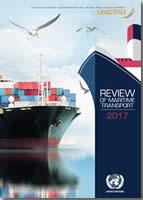
With over 80 per cent of global trade by volume and more than 70 per cent of its value being carried on board ships and handled by seaports worldwide, the importance of maritime transport for trade and development cannot be overemphasized.
Recognizing the sector’s strategic function, the global policy framework under the Addis Ababa Action Agenda and the 2030 Agenda for Sustainable Development underscores the role of trade – and by extension, seaborne trade – as an engine for inclusive and sustainable growth and development.
The Review of Maritime Transport 2017 presents key developments in the world economy and international trade and related impacts on shipping demand and supply, and freight and charter markets in 2016 and early 2017, as well as seaports and the regulatory and legal framework.
In addition, this year’s Review features a special chapter on maritime transport connectivity, reflecting the prominence of physical and electronic connectivity as a priority area in the trade and development policy agenda.
Ocean shipping will remain the most important mode of transport for international merchandise trade.
Ministries of transport and planning, and maritime and port authorities need to understand the determinants of maritime transport connectivity, as well as the associated opportunities and risks, to ensure informed policy and decision-making processes and adequate investment plans in shipping, ports and their hinterland connections.


